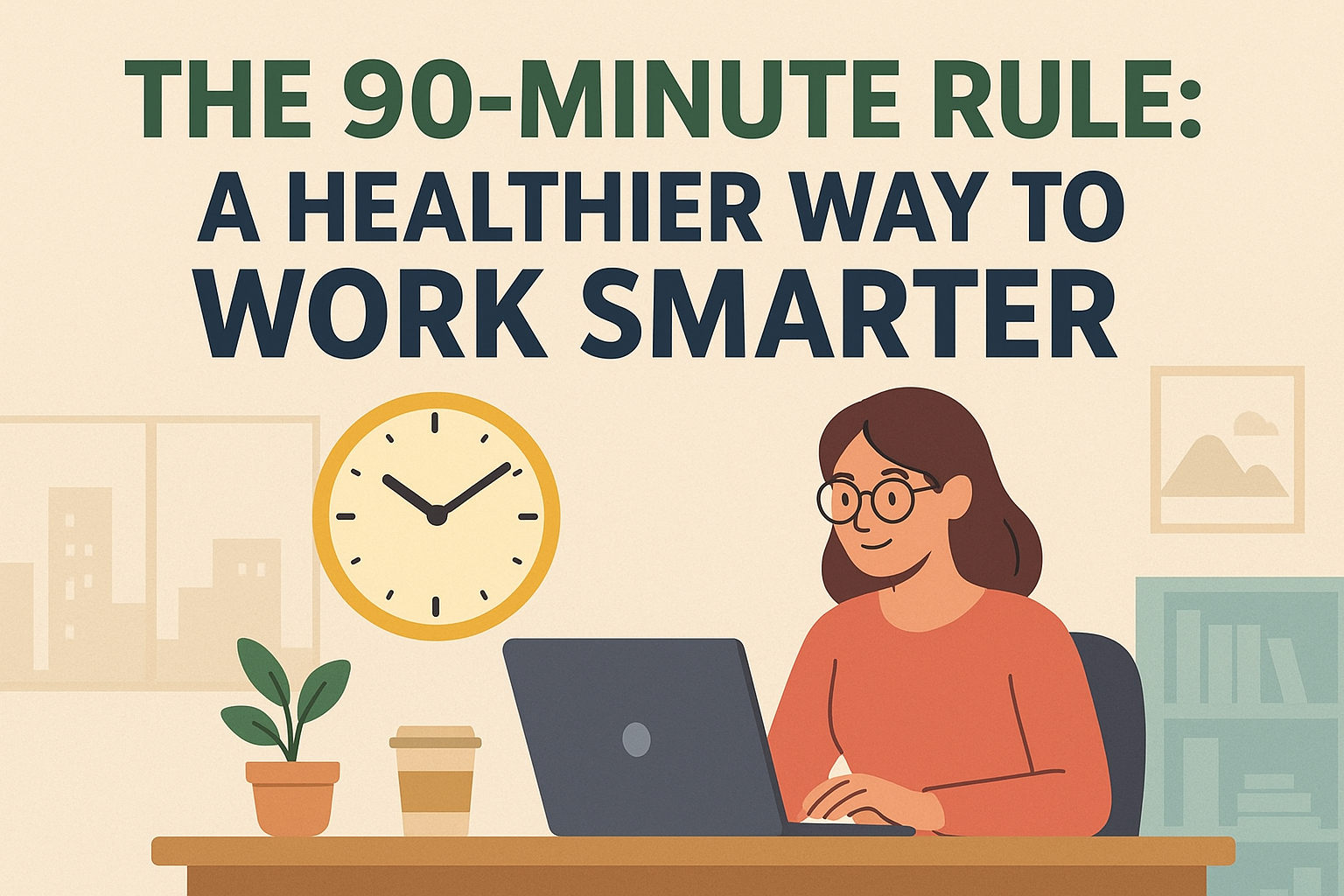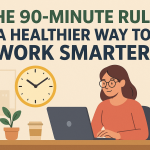The 90 Minute Rule: A Healthier Way to Work Smarter
Boost Focus, Reduce Burnout, and Get More Done — the Smarter Way Americans Are Redefining Productivity
In today’s fast-paced U.S. work culture, being busy has become a badge of honor. From corporate offices to remote setups, millions of Americans push themselves through long hours, back-to-back meetings, and endless to-do lists. But here’s the truth: working longer doesn’t mean working better.
Enter the 90 Minute Rule — a proven, science-backed method to help you work smarter, not harder. It’s transforming how professionals approach productivity, focus, and overall well-being.
What Is the 90-Minute Rule?
The 90 Minute Rule is based on the idea that the human brain functions best in ultradian rhythms — natural cycles that last around 90 minutes. During these cycles, your body and brain move through peaks and dips of alertness and energy.
In simple terms, your brain can sustain deep focus for about 90 minutes before it starts to lose efficiency. After that, you need a short break — typically 15 to 20 minutes — to recharge.
So instead of pushing through fatigue or distraction, the 90 Minute Rule encourages you to:
- Work deeply and intensely for 90 minutes.
- Then take a short, genuine break.
This rhythm aligns with how your brain naturally operates, helping you perform better without burning out.
The Science Behind It
Research by sleep expert Nathaniel Kleitman, who discovered the “Basic Rest-Activity Cycle,” revealed that our brains go through 90 Minute waves of energy and fatigue even during the day. This is similar to the sleep cycles we experience at night.
When you respect these natural rhythms, you’re giving your brain the rest it needs to stay creative, focused, and resilient. Ignoring them — as many American workers do — leads to brain fog, irritability, and burnout.
Why the 90 Minute Rule Works (Especially for Americans)
In the U.S., workplace stress and overwork are serious concerns. According to the American Institute of Stress, about 83% of U.S. workers experience job-related stress, and burnout costs businesses billions each year in lost productivity.
Here’s how the 90 Minute Rule helps fix that:
1. Increases Deep Focus
By dedicating a specific 90 Minute block to one task, you minimize distractions — no emails, no phone notifications. It helps you enter a state of “flow,” where time seems to slow down and work feels effortless.
2. Reduces Decision Fatigue
Americans make thousands of small decisions daily — from choosing breakfast to handling emails. The 90 Minute structure simplifies your day into predictable focus and rest periods, reducing cognitive load.
3. Prevents Burnout
Working non-stop drains your energy reserves. Taking short breaks helps your brain recover, preventing the exhaustion that leads to burnout — something nearly half of U.S. professionals report experiencing.
4. Improves Work-Life Balance
By focusing efficiently during the day, you finish tasks faster, leaving more time for family, hobbies, or self-care — all of which contribute to better mental health and overall happiness.
How to Implement the 90 Minute Rule in Your Daily Routine
Adopting the 90-Minute Rule doesn’t require a major lifestyle overhaul. Here’s a simple step-by-step plan to start working smarter:
Step 1: Identify Your Peak Hours
Figure out when your energy levels are naturally highest — morning, midday, or afternoon. Schedule your most demanding tasks during those times.
Step 2: Block 90 Minute Sessions
Use a timer or productivity app to create uninterrupted 90-minute work blocks. Close all social media tabs, silence notifications, and let coworkers know you’re in focus mode.
Step 3: Take a 15–20 Minute Break
After each 90-minute session, step away from your workspace. Stretch, walk, hydrate, or do breathing exercises. Avoid screens during this time — it’s about recharging, not scrolling.
Step 4: Track Your Results
Notice how your energy, focus, and mood change after a week of following this rhythm. Many professionals report feeling less stressed and more productive within just a few days.
Step 5: Protect Your Boundaries
In a “hustle culture,” it can feel strange to take breaks. But remember, rest is part of performance. Set clear boundaries with colleagues or clients to respect your focus and recovery periods.
Also Read : 10 Daily Habits to Reduce Work Stress Naturally
Example: A 9-to-5 Workday Using the 90 Minute Rule
| Time | Focus Session | Activity |
|---|---|---|
| 9:00 – 10:30 AM | Deep Work 1 | Write reports, code, or design |
| 10:30 – 10:50 AM | Break 1 | Walk or grab coffee |
| 10:50 – 12:20 PM | Deep Work 2 | Team tasks or strategy |
| 12:20 – 1:20 PM | Lunch Break | Relax and eat mindfully |
| 1:20 – 2:50 PM | Deep Work 3 | Calls or creative work |
| 2:50 – 3:10 PM | Break 2 | Stretch or meditate |
| 3:10 – 4:40 PM | Deep Work 4 | Emails, planning next day |
By structuring your day this way, you get six solid hours of real productivity, instead of eight hours of distracted multitasking.
Real Benefits Seen in U.S. Workplaces
Several U.S.-based companies, startups, and freelancers are already adopting the 90-Minute Rule — and seeing measurable improvements.
- Higher output: Teams report a 20–30% increase in task completion rates.
- Less burnout: Employees feel more energized and motivated.
- Better retention: Companies embracing healthier work rhythms experience lower turnover rates.
90-Minute Rule vs. Traditional Productivity Methods
| Productivity Method | Focus Duration | Approach | Key Weakness |
|---|---|---|---|
| Pomodoro Technique | 25 minutes | Short bursts | Too fragmented for deep work |
| 90 Minute Rule | 90 minutes | Long, focused sessions | Requires discipline |
| Traditional Workday | Continuous | Unstructured | Leads to fatigue and distraction |
The 90 Minute Rule offers the perfect middle ground — long enough for flow, short enough to prevent burnout.
Tips to Make It Work for You
- Start Small – Try one 90 Minute session per day before restructuring your whole schedule.
- Pair with Mindfulness – Use short meditation or breathing exercises during breaks.
- Avoid Multitasking – Focus on one project or goal per session.
- Hydrate and Move – Your brain performs better when you stay hydrated and active.
- Review Weekly – Reflect on what worked and adjust your time blocks accordingly.
The Takeaway
The 90 Minute Rule isn’t just a productivity trick — it’s a mindset shift. It’s about honoring how your brain naturally works and giving yourself permission to rest without guilt.
For American professionals juggling deadlines, remote work, and personal commitments, this rule offers a sustainable path toward better focus, higher creativity, and improved well-being.
Remember, working smarter isn’t about squeezing more into your day — it’s about designing your day to get the right things done with less stress and more satisfaction.
So tomorrow, set a timer for 90 minutes, close your inbox, and give it a try. You’ll be amazed how much better work feels when you work with your brain — not against it.






